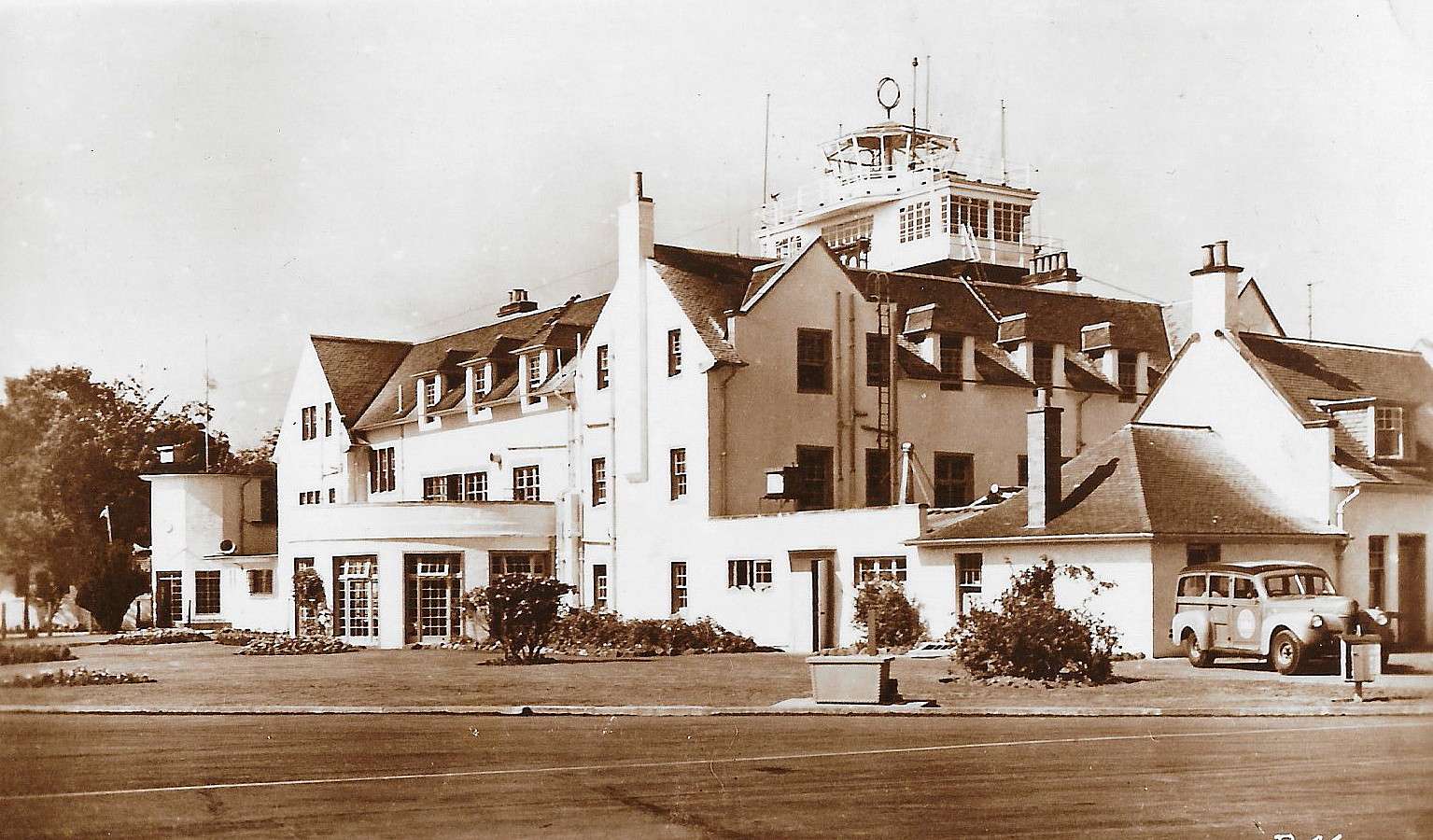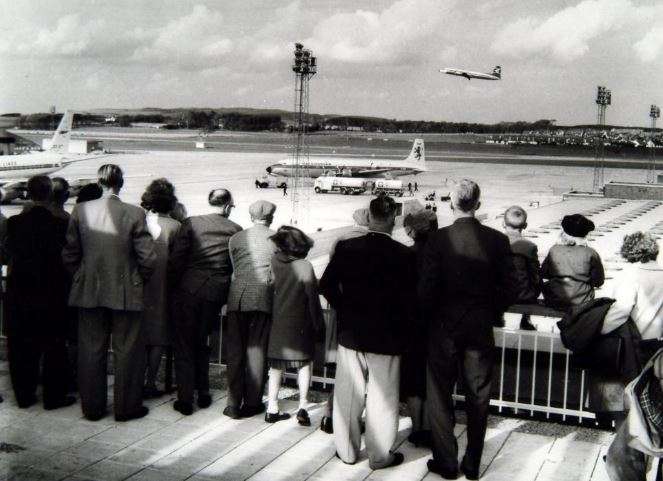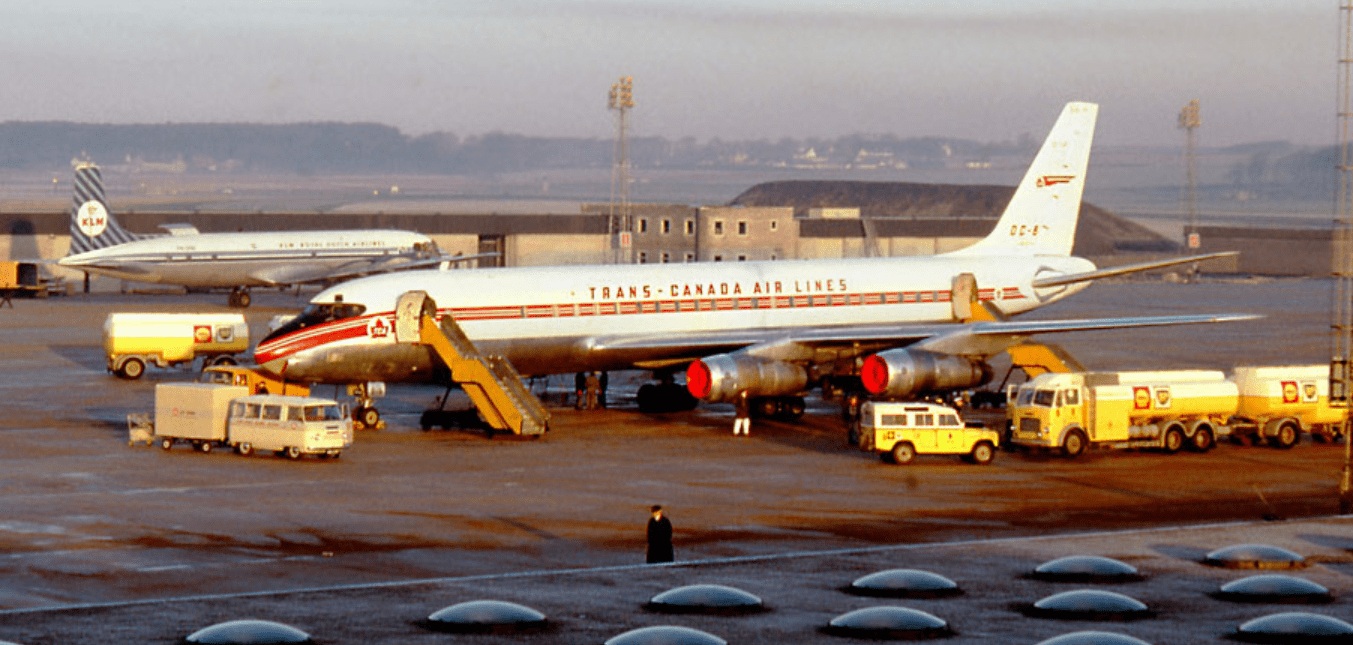Many ex-pat Scots will have flown from Prestwick Airport in Ayrshire to start new lives in the United States and Canada and for many the airport holds a special place in their heart. The same will apply to the thousands of US and Canadian servicemen who transited through Prestwick during both World War 2 and the Cold War era as well as those who were actually based at the airfield. In this short article, local enthusiast, Allan Mackintosh outlines the history of the airfield from the first recorded early aviation activity in 1913 through to the present day.

The first recorded aviation activity at Prestwick was recorded in July 1913 when three Royal Flying Corps BE.2a biplanes who were supporting Territorial Army manoeuvres at Gailes just up the coast, used the Monkton ‘Meadows’ as a landing ground in between sorties. After this event there is no official recorded activity through the 1920s with most aviation activity being centred at the airstrip at Ayr Racecourse. However, with the increase in aviation activity in the early 1930s and in particular with pleasure flights from Renfrew to the beaches of Prestwick and Ayr there was the odd occasion that a plane set off from Renfrew only to find the beach at Prestwick had the tide in and as it couldn’t land, used the fields of the Monkton Meadows as a relief landing ground. It was also during this period that Midland & Scottish Air Ferries started to use Monkton as a diversionary landing ground for Renfrew, when fog and low cloud regularly closed the Glasgow airfield. This was the start of the realisation that Monkton (soon to be renamed Prestwick) offered a safe haven for passenger and mail aircraft on a regular basis given the excellent weather record of the area. This resulted in the airfield becoming a fully licensed aerodrome in 1934.
The year before in 1933, two young pilots, David McIntyre, and Douglas Douglas-Hamilton members of No.602 City of Glasgow Auxiliary Air Force Squadron, were one of a pair of aircraft to be the first to successfully fly over Mount Everest. Both men had experience of flying into the Monkton Meadows and David McIntyre, in particular, had a real passion for the airfield to be developed further. After evaluating several local sites, McIntyre, and Douglas-Hamilton, in conjunction with the De Havilland company, set up Scottish Aviation Ltd, based initially around an ‘Elementary Flying School’ training pilots and navigators for the Royal Air Force. The ‘new’ airfield was built just beside the Monkton Meadows close to Orangefield House, which was later to become Prestwick’s first true passenger terminal. (The first ‘terminal’ was actually a Midland & Scottish Transport bus which kept diverted passengers dry and warm whilst awaiting their limousine transport back to Renfrew!)
International airfield

With the advent of World War 2 in 1939, Prestwick grew from being a small training airfield to a fully functioning international airfield, becoming the preferred landing ground for many aircraft entering the war arena from the US and Canada. Between 1941 and 1945, 37,000 aircraft movements were recorded. Initially RAF Aldergrove (now Belfast International) was the preferred landing ground for the ‘Atlantic Ferry Organisation’ but with Prestwick having a better weather record, the Ayrshire airfield was finally chosen as the preferred airfield. With the increase in aircraft activity, there was also an increase in aircraft related maintenance, repair, and conversion work so Scottish Aviation’s work grew to the extent that new hangers and buildings had to be erected quickly to cater for the increase in work. The main hanger (which is still in place today, along with most of the wartime hangers) was affectionally known as ‘The Palace’ (and still is) and this is the Palace of Engineering which took pride of place at the Glasgow Empire Exhibition in Glasgow’s Bellahouston Park in 1938. The building was moved to Prestwick ‘brick by brick’ over a four-month period between April and September 1940 and still stands proudly overseeing today’s international airport.
Post war airline passenger travel through the airport started once again from 1946. In the post war years, Prestwick was afforded ‘transatlantic’ status and initially was one of only two UK airports (the other being the new London-Heathrow) to be allowed this status. From Prestwick there were regular flights to and from the US and Canada and the airport proved to be a great staging post for flights from France, Belgium, Holland, and Scandinavia. Prestwick’s Orangefield terminal offered a service second to none and was the first UK Airport to offer duty-free. At this time London Heathrow was an unsightly mass of temporary huts!

In 1955, the military returned to the airfield in the form of the United States Air Force with a major base at Prestwick and Elvis Presley visited in 1960 for a brief stopover and this made the airport the only place where he set foot in the UK (there are claims that Elvis was also secretly in London but it was obviously so secret that there is no physical evidence of this!)
Scottish Aviation remained a world-leader is aircraft maintenance and aircraft design and manufacturing commences with the Prestwick Pioneer. This leads to the manufacture of the Twin Pioneer in the late 1950s and in later years (60s through to the early 90s) the company produces the successful Jetstream family of commuter airliners, and the equally successful Bulldog, a military basic trainer.
With the introduction of the jet-age in the late 1950s, Prestwick had to expand to keep pace and the main runway was extended to 9800ft and a new secondary runway was built to the south-west of the airfield. A new terminal building, freight building, control tower and loop road around the airport was built, with sadly, the old Orangefield terminal being demolished to make way for a new parallel taxiway. The runway extension was actually implemented to serve the US Air Force and it conforms to the standard US military specification of the day. This is one of very few runways in the UK to do so and still to this day one it is of the longest. This enables Prestwick to be able to handle the world’s largest freighters with full loads and was one of the factors leading to the frequent Concorde training flights in the 70s.
The World O’er

During the late 80s and early 90s, with the expansion of the airports at Glasgow and Edinburgh, Prestwick’s monopoly became under threat and ultimately ‘Open Skies’ was introduced to allow airports to compete. With Glasgow’s and Edinburgh’s airports now able to accommodate the large passenger jets (as well as being on the outskirts of the cities), in time, all transatlantic passenger airlines moved to the city airports. This left Prestwick in a perilous position and with the owner, the British Airports Authority (BAA), also owning Glasgow and Edinburgh, the airport looked doomed, with property developers lining up to offer to buy the site and redevelop it for housing and industrial units. However, a dynamic group of investors, led by a Canadian lawyer, Mathew Hudson, supported by the boss of British Aerospace, Alan Macdonald, saved the day by ‘persuading’ BAA to sell them the airport. Whilst BAA were reluctant to sell to a ‘competitor’, there was a clause in the 99-year lease given to Scottish Aviation that stipulated that the airport runways could not be sold unless Scottish Aviation (now British Aerospace) allowed it. As British Aerospace needed the runways for their flying college and for the demonstration and testing of their Jetstreams, they were not for giving the runways up!

The airport was now under new dynamic ownership and from 2004 went from strength to strength as a result of new investment (including the airport’s own rail station) and also due to the low-cost airline revolution. The airport hit 2.5 million passengers per annum in 2006 although, once again, Glasgow and Edinburgh increased their competition practices, with the result that Prestwick’s main airline, Ryanair moved some services to both Glasgow and Edinburgh. Today Prestwick handles close to 800,000 passengers per annum although passenger incomes are now only a fraction of the airport’s main income with property rentals, maintenance, technical stops, cargo, training, and refuelling bring in most revenue. The airport at present has returned to its military roots with the Royal Canadian Air Force maintaining a base there and the Air Forces of the US, Oman, Abu Dhabi, UAE, Kuwait, and Israel using the airport for fuel and overnight stops. Cargo volumes remain strong, with regular cargo schedules maintained by Cargolux and Air France.

Today, The airport is owned by the Scottish Government, who see the facility as an important infrastructure asset that helps to support in excess of 4,000 jobs in the West of Scotland. It’s the heart of Scotland’s aerospace industry, with over 50% of the country’s aerospace workforce employed at Prestwick, offering a diverse range of aviation services, and providing vital connections to the rest of the world. Next stop – space!
The motto of Scottish Aviation ‘The World O’er’ remains as strong today as it did in 1935.
Allan Mackintosh has started Prestwick Aviation Tours to bring the amazing and fascinating story of Prestwick to life. At present, there are short walking tours of a portion of the perimeter of the airfield, where Allan guides the tourists through the story of the airfield from 1913 to the present day. There are plans for a virtual tour to be up and running in 2024 so that the many ex-pats and service personnel who flew to and from Prestwick can experience the airfield’s story. Allan can be contacted on +44 (0) 776 416 8989 or via email [email protected] The website is: https://prestwickaviationtours.com
Main photo: A Trans-Canada Air Lines, DC-8 at Prestwick, 1960s.


Yes prestwick airport has great history I first visited there in may 1960 usaf open day great days